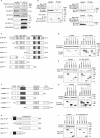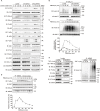Cellular and Mathematical Analyses of LUBAC Involvement in T Cell Receptor-Mediated NF-κB Activation Pathway
- PMID: 33329596
- PMCID: PMC7732508
- DOI: 10.3389/fimmu.2020.601926
Cellular and Mathematical Analyses of LUBAC Involvement in T Cell Receptor-Mediated NF-κB Activation Pathway
Abstract
The LUBAC ubiquitin ligase complex, composed of the HOIP, HOIL-1L, and SHARPIN subunits, stimulates the canonical nuclear factor-κB (NF-κB) activation pathways through its Met1-linked linear ubiquitination activity. Here we performed cellular and mathematical modeling analyses of the LUBAC involvement in the T cell receptor (TCR)-mediated NF-κB activation pathway, using the Jurkat human T cell line. LUBAC is indispensable for TCR-induced NF-κB and T cell activation, and transiently associates with and linearly ubiquitinates the CARMA1-BCL10-MALT1 (CBM) complex, through the catalytic HOIP subunit. In contrast, the linear ubiquitination of NEMO, a substrate of the TNF-α-induced canonical NF-κB activation pathway, was limited during the TCR pathway. Among deubiquitinases, OTULIN, but not CYLD, plays a major role in downregulating LUBAC-mediated TCR signaling. Mathematical modeling indicated that linear ubiquitination of the CBM complex accelerates the activation of IκB kinase (IKK), as compared with the activity induced by linear ubiquitination of NEMO alone. Moreover, simulations of the sequential linear ubiquitination of the CBM complex suggested that the allosteric regulation of linear (de)ubiquitination of CBM subunits is controlled by the ubiquitin-linkage lengths. These results indicated that, unlike the TNF-α-induced NF-κB activation pathway, the TCR-mediated NF-κB activation in T lymphocytes has a characteristic mechanism to induce LUBAC-mediated NF-κB activation.
Keywords: CBM complex; LUBAC; NF-κB; T cell receptor; linear ubiquitin; mathematical model.
Copyright © 2020 Oikawa, Hatanaka, Suzuki and Tokunaga.
Conflict of interest statement
The authors declare that the research was conducted in the absence of any commercial or financial relationships that could be construed as a potential conflict of interest.
Figures







Similar articles
-
Molecular Determinants of Scaffold-induced Linear Ubiquitinylation of B Cell Lymphoma/Leukemia 10 (Bcl10) during T Cell Receptor and Oncogenic Caspase Recruitment Domain-containing Protein 11 (CARD11) Signaling.J Biol Chem. 2016 Dec 9;291(50):25921-25936. doi: 10.1074/jbc.M116.754028. Epub 2016 Oct 24. J Biol Chem. 2016. PMID: 27777308 Free PMC article.
-
The LUBAC participates in lysophosphatidic acid-induced NF-κB activation.Cell Immunol. 2020 Jul;353:104133. doi: 10.1016/j.cellimm.2020.104133. Epub 2020 May 18. Cell Immunol. 2020. PMID: 32450431
-
Malt1 ubiquitination triggers NF-kappaB signaling upon T-cell activation.EMBO J. 2007 Nov 14;26(22):4634-45. doi: 10.1038/sj.emboj.7601897. Epub 2007 Oct 18. EMBO J. 2007. PMID: 17948050 Free PMC article.
-
Linear Ubiquitin Code: Its Writer, Erasers, Decoders, Inhibitors, and Implications in Disorders.Int J Mol Sci. 2020 May 11;21(9):3381. doi: 10.3390/ijms21093381. Int J Mol Sci. 2020. PMID: 32403254 Free PMC article. Review.
-
Linear ubiquitination: a novel NF-κB regulatory mechanism for inflammatory and immune responses by the LUBAC ubiquitin ligase complex.Endocr J. 2012;59(8):641-52. doi: 10.1507/endocrj.ej12-0148. Epub 2012 May 19. Endocr J. 2012. PMID: 22673407 Review.
Cited by
-
Ubiquitination in T-Cell Activation and Checkpoint Inhibition: New Avenues for Targeted Cancer Immunotherapy.Int J Mol Sci. 2021 Oct 6;22(19):10800. doi: 10.3390/ijms221910800. Int J Mol Sci. 2021. PMID: 34639141 Free PMC article. Review.
-
Differential protein-protein interactions underlie signaling mediated by the TCR and a 4-1BB domain-containing CAR.Sci Signal. 2024 Mar 5;17(826):eadd4671. doi: 10.1126/scisignal.add4671. Epub 2024 Mar 5. Sci Signal. 2024. PMID: 38442200 Free PMC article.
-
MALT1 substrate cleavage: what is it good for?Front Immunol. 2024 May 28;15:1412347. doi: 10.3389/fimmu.2024.1412347. eCollection 2024. Front Immunol. 2024. PMID: 38863711 Free PMC article. Review.
-
Editorial: Community series in adaptor molecules in T cell signaling, volume II.Front Immunol. 2023 Jul 26;14:1243039. doi: 10.3389/fimmu.2023.1243039. eCollection 2023. Front Immunol. 2023. PMID: 37564638 Free PMC article. No abstract available.
References
Publication types
MeSH terms
Substances
LinkOut - more resources
Full Text Sources
Other Literature Sources
Research Materials
Miscellaneous

